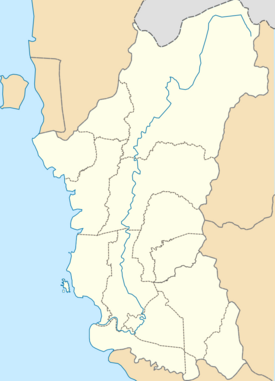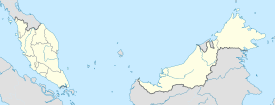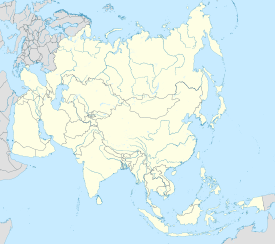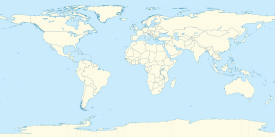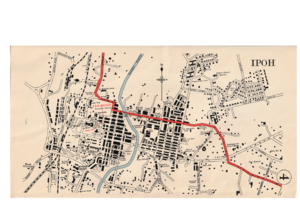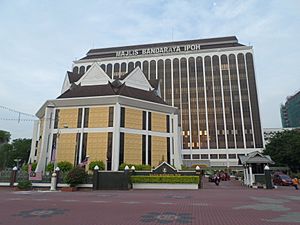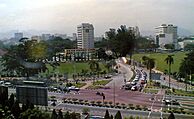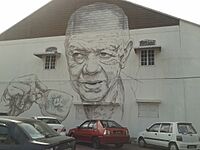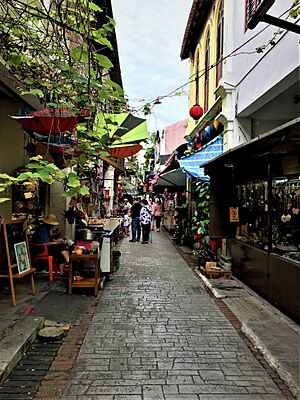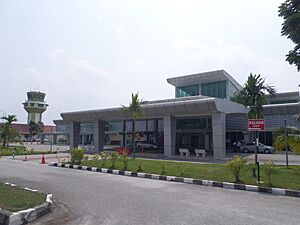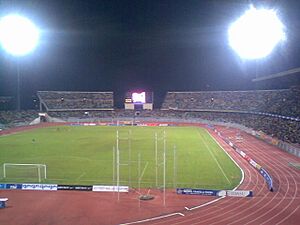Ipoh facts for kids
Quick facts for kids
Ipoh
|
|||
|---|---|---|---|
|
City and state capital
|
|||
| City of Ipoh Bandaraya Ipoh |
|||
| Other transcription(s) | |||
| • Jawi | ايڤوه | ||
| • Mandarin | 怡保 (Simplified) 怡保 (Traditional) Yíbǎo (Hanyu Pinyin) |
||
| • Cantonese | ji4 bou2 (Jyutping) yìh-bóu (Yale Romanisation) |
||
| • Tamil | ஈப்போ Īppō (Transliteration) |
||
|
From top, left to right:
Ipoh city skyline, Old downtown, St. Michael's Institution, Ipoh railway station, City Hall, Kinta Nature Park, Gunung Lang Recreational Park, and Tambun limestone |
|||
|
|||
| Nickname(s):
City of Millionaires, Bougainvillea City, Mountain City, Silver Valley
|
|||
| Motto(s):
Berkhidmat dan Maju
English: Service and Progress |
|||
| Country | |||
| State | |||
| District | Kinta | ||
| Establishment | Around 1880 | ||
| Establishment of the local government | 1893 | ||
| Municipality status | May 31, 1962 | ||
| City status | 27 May 1988 | ||
| Government | |||
| • Type | City council | ||
| • Body | Ipoh City Council | ||
| Area | |||
| • City and state capital | 643 km2 (248 sq mi) | ||
| Elevation | 51.85 m (170.11 ft) | ||
| Population
(2021)
|
|||
| • City and state capital | 840,000 | ||
| • Density | 1,023/km2 (2,650/sq mi) | ||
| • Metro | 1,022,240 | ||
| Demonym(s) | Ipohian / Ipohite | ||
| Time zone | UTC+8 (MST) | ||
| • Summer (DST) | Not observed | ||
| Postcode |
30xxx, 31xxx
|
||
| Area code(s) | 05 | ||
Ipoh (/ˈiːpoʊ/, Malay pronunciation: [i.poh]) is the capital city of the Malaysian state of Perak. Located by the Kinta River, it is nearly 200 km (120 mi) north of Kuala Lumpur and 150 km (93 mi) southeast of George Town in neighbouring Penang. As of the 2020 census Ipoh had a population of 759,952, making it the eighth-largest city in Malaysia by population.
In recent years, Ipoh's popularity as an international tourist destination has been significantly boosted by efforts to conserve its British colonial-era architecture. The city is also well known for its cuisine and natural attractions, such as its limestone hills and caves within which Buddhist temples were built.
Ipoh's location between Kuala Lumpur and George Town has made it a major land transportation hub within West Malaysia, with both the Malayan Railway's West Coast Line and the North-South Expressway cutting through the city. Aside from the land transportation links, Ipoh is also served by the Sultan Azlan Shah Airport.
Contents
Etymology
The name Ipoh is derived from a local tree, pohon epu, now more commonly known as pokok ipoh. The sap of this plant is poisonous and was used by local indigenous people mixed with Strychnos latex to coat the tips of their blowpipe darts for hunting.
History
Originally a village, Ipoh began to grow rapidly in the 1880s after huge deposits of tin were discovered within its vicinity. Its geographic location in the rich tin-bearing valley of the Kinta River made it a natural centre of growth.
The Great Fire of Ipoh in 1892 destroyed over half the town, but also presented an opportunity to rebuild the town in a more orderly grid pattern. By 1895, it was the second largest town within the Federated Malay States, which also consisted of Selangor, Negeri Sembilan, and Pahang.
Ipoh was subsequently rebuilt in time for the second tin rush and grew rapidly as a result of the booming tin mining industry, particularly in the 1920s and 1930s.
A local Hakka miner, millionaire Yau Tet Shin, started developing a large tract of the town in the early 1930s, today known as the "New Town", from the eastern bank of the Kinta River to Greentown. In 1937, Ipoh was made the capital of Perak, replacing Taiping.
Ipoh was invaded by the Japanese on 15 December 1941. In March 1942, the Japanese Civil Administration or Perak Shu Seicho was set up at St. Michael's Institution. After the liberation of Malaya by British forces, Ipoh remained the capital of Perak as it does to this day.
Following the depletion of its tin deposits and the collapse of tin prices in the 1970s, the city suffered decades of decline and neglect. With the closure of the tin mines, its urban population was forced to seek employment in other cities within Malaysia. In spite of this, Ipoh remains one of the largest cities in Malaysia in terms of population, with tourism now a main driver of the city's economy.
Ipoh gained Municipal status in 1962, and in 1988 it was declared a city by the then Sultan of Perak, Sultan Azlan Shah.
Geography
Topography
Ipoh is in the state of Perak, which is in the central part of Peninsular Malaysia. The city is in the middle of the karstic Kinta Valley region, on the bank of the Kinta River and the confluence of the smaller rivers Sungai Pinji and Sungai Pari. Hills of limestone, called mogotes, surround the city, which can be found around suburban areas to the northeast, east and southeast.
The Keledang mountain range stretches from the north to the west of the city. This range runs parallel to the Bintang mountain range with the Perak River running on its left bank and the Kinta River to its right. This range is interrupted to the north of Ipoh by a tributary of the Perak River called the Pelus River, which is sourced from the Titiwangsa mountain range, which runs to the east of Ipoh.
Climate
Ipoh has a tropical rainforest climate. Ipoh is more subject to the Intertropical Convergence Zone than the trade winds and very rarely has cyclones, therefore it can be described as having an equatorial climate. The city's temperature shows little variation throughout the year, the average temperature being 28 °C (82 °F). Ipoh sees high precipitation throughout the year with an average of 200 mm (7.9 in) of rain each month and averaging 2,897.0 mm (114.06 in) of rain per year. The wettest month is October when on average 307.1 mm (12.09 in) of rain falls. Ipoh's driest month is January which has 256.3 mm (10.09 in) of rainfall on average.
| Climate data for Ipoh (2016–2021) | |||||||||||||
|---|---|---|---|---|---|---|---|---|---|---|---|---|---|
| Month | Jan | Feb | Mar | Apr | May | Jun | Jul | Aug | Sep | Oct | Nov | Dec | Year |
| Mean daily maximum °C (°F) | 32.5 (90.5) |
33.8 (92.8) |
34.2 (93.6) |
33.6 (92.5) |
33.1 (91.6) |
33.1 (91.6) |
33.1 (91.6) |
33.2 (91.8) |
32.7 (90.9) |
32.7 (90.9) |
32.2 (90.0) |
32.2 (90.0) |
33.0 (91.5) |
| Mean daily minimum °C (°F) | 23.5 (74.3) |
23.6 (74.5) |
24.2 (75.6) |
24.6 (76.3) |
24.7 (76.5) |
24.4 (75.9) |
24.3 (75.7) |
24.2 (75.6) |
23.8 (74.8) |
24.1 (75.4) |
24.0 (75.2) |
23.8 (74.8) |
24.1 (75.4) |
| Average precipitation mm (inches) | 132.3 (5.21) |
149.8 (5.90) |
169.9 (6.69) |
259.1 (10.20) |
210.9 (8.30) |
151.8 (5.98) |
156.6 (6.17) |
157.8 (6.21) |
216.0 (8.50) |
297.2 (11.70) |
275.4 (10.84) |
251.1 (9.89) |
2,427.9 (95.59) |
| Average precipitation days (≥ 1.0 mm) | 9 | 10 | 12 | 14 | 14 | 10 | 10 | 12 | 15 | 18 | 18 | 15 | 157 |
| Source 1: Meteomanz | |||||||||||||
| Source 2: World Meteorological Organisation (precipitation) | |||||||||||||
Limestone caves
Mogotes are the most prominent natural features of the city. There are many caves in these outcrops, some of which have cave temples built in them. The Sam Poh Tong Temple is a notable example, along with Kek Lok Tong; Cavern of Utmost Happiness), which lies on the other side of the same outcrop. It is accessible through the Gunung Rapat housing area. Other cave temples in Ipoh include Ling Sen Tong, Nan Tian Tong, Kwan Yin Tong and Perak Tong.
Gua Tempurung, near Gopeng, south of Ipoh, is a show cave open to the public and popular among spelunkers. More than 3 km (1.9 mi) long, it is one of the longest caves in Peninsular Malaysia. Part of it has been developed with electric lighting and walkways, and there are tours of varying lengths and difficulty. A river passage runs about 1.6 km (0.99 mi) through the hill. There are five large chambers, filled with spectacular speleothems which include stalactites and stalagmites.
Economy
In its early history, Ipoh as a settlement was built around its mining industry, although inferior to that of Gopeng, some 19 kilometres (12 mi) to the south. Ipoh was once one of the richest cities in Malaysia and South East Asia, in the days when tin was its major product. During the 1980s, when tin prices collapsed, the economy of Ipoh was affected significantly. However, the city has since experienced economic growth. The city of Ipoh hosts the headquarters of several large multinational corporations, such as: Kuala Lumpur Kepong Berhad, a major palm oil company; Batu Kawan Berhad, an investment company which holds the majority share in Kuala Lumpur Kepong Berhad; Hovid Berhad, a major Malaysian pharmaceutical company; and Old Town White Coffee (or Old Town Berhad), a food and beverage giant originating from Ipoh which specializes in white coffee. Other public listed companies in Ipoh include, Perak Transit Berhad, Tasek Cement Berhad, DKLS Industries Berhad, Wellcall Holding Berhad, Rubberex Berhad, and Perak Corp. Ipoh also hosts the Malaysian headquarters for several foreign multinational companies, including Finisar, Voith, ITL Asia Pacific, and Sagami Manufacturers.
Governance
The Ipoh City Council governs the city. Datuk Rumaizi Baharin, appointed in April 2020, is the current mayor of Ipoh.
Ipoh is divided into two parliamentary constituencies: Ipoh Barat (Ipoh West) and Ipoh Timor (Ipoh East). The parliamentary seat for Ipoh Barat is held by Democratic Action Party (DAP) Representative M. Kulasegaran. The seat for Ipoh Timor is held by fellow DAP leader Howard Lee Chuan How. As of 2022, there were 233,000 voters in Ipoh. Most of the voters in Ipoh are Chinese, followed by Malays, Indians and others.
Ethnic breakdown of Ipoh's electorate as of 2022 Chinese (63.55%) Malay (18.49%) Indian (17.04%) Other ethnicities (0.92%)
Demographics
Ipoh remains one of Malaysia's largest cities. As of 2010, the municipal area of Ipoh has a population of 657,892. It ranks as the seventh most populous urban centre in Malaysia (2010).
The following is based on Department of Statistics Malaysia 2010 census.
| Ethnic groups in Ipoh, 2010 | ||
|---|---|---|
| Ethnicity | Population | Percentage |
| Chinese | 270,165 | 44.11% |
| Bumiputera | 253,592 | 38.55% |
| Indian | 110,024 | 14.07% |
| Others | 1,559 | 0.2% |
| Non-Malaysian | 19,989 | 3.04% |
Town Layout / Cityscape
See List of Ipoh areas
Culture
Cuisine
Ipoh has a significant food scene with many hawker centres and restaurants. It has dishes derived from Malay, Chinese and Indian cuisine. See
Film and television
Movies filmed in Ipoh include:
- 1992: Indochine
- 1999: Anna and the King
- 2003: Kadhal Kisu Kisu
- 2005: Sepet
- 2005: Gubra
- 2006: After This Our Exile
- 2006: Goodbye Boys
- 2006: ... Caution
- 2015: Blackhat
Greenery & Public Parks
- D. R. Seenivasagam Park (Coronation Park)
- Sultan Abdul Aziz Recreational Park (Polo Ground)
- Kledang Saiong Forest Eco Park
- Botani Eco Park
Theme parks
There are several theme parks in Ipoh, including the Sunway Lost World of Tambun and the now defunct Movies Animated Park Studios (MAPS).
Famous attraction
Source:
- Qing Xing Ling Leisure & Cultural Village
- Perak Cave Temple
- Banjaran Hotsprings Retreat
- Tasik Cermin (Mirror Lake)
- Gunung Lang Recreational Park
- Pavilion Petting Zoo & Gunung Lang Climbing Park
- Funtasy House Trick Art
- Fujiwara Tofa Shop
- Kinta Riverfront
- Ipoh Town Hall
- Market Lane
Transport
Roads
The old interstate Federal Route 1 connects Ipoh with other major towns and cities in peninsular Malaysia, for example to Alor Setar, Taiping and Penang to the north and Tapah, Kuala Lumpur, Seremban and even Johor Bahru in the south. Motorists from the east coast can use Federal Route 4 (from Gerik) in northern Perak or Federal Route 185 (from Cameron Highlands).
The new North–South Expressway is a faster and more efficient alternative to Route 1. However, some towns such as Kampar can only be accessible via Route 1.
Train
Ipoh's railway station is operated by Keretapi Tanah Melayu (KTM) and is in the Old Town. However, it does not have intra-city travel like there is in Kuala Lumpur; the railway only connects Ipoh with neighbouring towns and cities. The station is a stately building, referred to by locals as the "Taj Mahal of Ipoh". KTM Intercity began the Shuttle Train Service between Kuala Lumpur and Ipoh from 1 December 2008 while the modern Electric Train System (ETS) shuttle began from 12 August 2010, with an average speed of 145 km/h (90 mph), plying the Ipoh-Seremban route, which cut the travelling distance between Ipoh and Kuala Lumpur to 120 minutes. There are 10 dedicated shuttle train services between these two cities daily, beginning at 5 am from both of the stations. Travel time between the cities was expected to be reduced from three hours to two hours and fifteen minutes when the new set of EMU trains arrived in mid-2009.
Bus
The inter-city bus terminal is located at Amanjaya Integrated Bus Terminal in Bandar Meru Raya, just north of the city. Medan Kidd is the public transport intracity terminal that is very near to Ipoh Railway Station. Currently, the main public transport operator in the city is PerakTransit under the branding of myBAS Ipoh.
Air
The Sultan Azlan Shah Airport is the only airport in Ipoh, located near Gunung Rapat. Domestic and international flights are available. Scoot and AirAsia provide daily flights from Ipoh to Singapore Changi Airport while Batik Air Malaysia used to provide daily flights to Senai International Airport, serving as a link to the city of Johor Bahru. There are also planned flights to Indonesia, Singapore, Thailand and China, with talks of a new airport soon.
Education
This is a list of schools in Ipoh, Perak.
- Sekolah Izzuddin Shah
- Sekolah Tuanku Abdul Rahman
- Sekolah Menengah Kebangsaan Bercham
- Sekolah Menengah Kebangsaan Tanjung Rambutan
- Sekolah Menengah Kebangsaan Seri Puteri
- Sekolah Jenis Kebangsaan (T) St. Philomena Convent, Ipoh
- Sekolah Kebangsaan Dato' Panglima Kinta, Ipoh
- Sekolah Jenis Kebangsaan (C) Yuk Choy, Ipoh
- SMJK Yuk Choy, Ipoh
- Tarcisian Convent School, Ipoh (TCS)
- Anderson School, Ipoh
- Anglo-Chinese School, Ipoh
- St. Michael's Institution, Ipoh
- SMK Jalan Tasek, Ipoh
- Methodist Girls Secondary School (MGS), Ipoh
- Perak Girls Secondary School (PGS), Ipoh
- SMK Main Convent, Ipoh
- Wesley Methodist School, Ipoh
- Ipoh International School (Private)
- Fairview International School, Ipoh
- Perak Yuk Choy High School (Private), Ipoh
- Poi Lam High School (Private), Ipoh
- Shen Jai High School (Private), Ipoh
- Sekolah Jenis Kebangsaan (T) Kerajaan, Sungai Pari, Ipoh
- Sekolah Jenis Kebangsaan (T) Gunung Rapat, Ipoh
- Sekolah Jenis Kebangsaan (T) Perak Sangeetha Sabha, Ipoh
- SMK Rapat Setia, Ipoh
- SMK Jalan Pasir Puteh, Ipoh
- Sekolah Jenis Kebangsaan (C) Poi Lam, Ipoh
- SMK Seri Keledang, Ipoh
- SMK Menglembu, Ipoh
- SMJK Poi Lam, Ipoh
- Sekolah Jenis Kebangsaan (C) Sam Tet, Ipoh
- SMJK Sam Tet, Ipoh
- SMK Dato Ahmad Said
- Sekolah Jenis Kebangsaan Ave Maria Convent, Ipoh
- SMJK Ave Maria Convent, Ipoh
- Sekolah Jenis Kebangsaan (C) Gunung Rapat, Ipoh
- Sekolah Jenis Kebangsaan (C) Wan Hwa (1)
- Sekolah Jenis Kebangsaan (C) Wan Hwa (2)
- Sekolah Kebangsaan (ACS), Ipoh
- Sekolah Kebangsaan (P) Methodist, Ipoh
- Sekolah Kebangsaan Haji Mahmud Chemor, Ipoh
- Sekolah Kebangsaan Kuala Pari, Ipoh
- Sekolah Kebangsaan Jalan Pegoh
- Sekolah Kebangsaan Jelapang
- Sekolah Kebangsaan Marian Convent, Ipoh
- Sekolah Kebangsaan Raja Ekram, Ipoh
- SMK Raja Perempuan, Ipoh (RPS) Royal Princess School "Cluster School"
- SRK Raja Perempuan, Ipoh (RPS)
- Sekolah Kebangsaan Seri Ampang, Ipoh
- Sekolah Kebangsaan St. Michael's Institution (1), Ipoh
- Sekolah Kebangsaan St. Michael's Institution (2), Ipoh
- Sekolah Jenis Kebangsaan (C) Chung Shan
Sports
Ipoh has a sports complex known as Kompleks Sukan MBI or MBI Sports Complex. Among the facilities located within the complex is the Perak Stadium (Malay: Stadium Perak), the home of Perak Football Association who play in the Malaysia Super League.
Golf courses in Ipoh include the Royal Perak Golf Club off Jalan Sultan Azlan Shah (Tiger Lane), the Meru Golf Club in Jelapang, and Clearwater Sanctuary Golf Club en route to Batu Gajah.
Other sports venues include the Kilat Club in Pasir Pinji, Ipoh Field (Padang Ipoh) in the Old Town, the Polo Grounds, and the Iskandar Polo Club in Ampang Baru.
The Sultan Azlan Shah Cup is an annual international men's field hockey tournament held in Ipoh.
Notable people
Film and television
- Angie Cheong, actress
- Mimi Chu, actress and singer
- Iqram Dinzly, actor and model
- Mamat Khalid, film director and screenwriter
- Peter Pek, TV host and businessman
- Afdlin Shauki, screenwriter, director and actor
- Patrick Teoh, actor and radio host
- Michelle Yeoh, actress famous for role in Crouching Tiger, Hidden Dragon
- Natasha Hudson, actress and model
- Mandy Lieu, actress and model
Music
- Michael Wong, singer-songwriter
- Jamal Abdillah, pop singer and actor
- Shila Amzah, singer-songwriter and actress
- Ning Baizura, pop and R&B singer, actress
- Francissca Peter, singer-songwriter
- Sophia Liana
- Sam Chin Neng of pop duo Fuying & Sam
Sports (badminton)
- Koo Kien Keat
- Choong Tan Fook
- Lee Wan Wah
- Cheah Soon Kit
- Wong Pei Tty
- Wong Mew Choo
Sports (football)
- Nazirul Naim
- Chan Kok Heng
- Muhamad Khalid Jamlus
- Azizon Abdul Kadir
Sports (others)
- Tony Underwood (rugby)
- Nur Suryani Mohd Taibi (sports shooting)
- Leong Mun Yee (diving)
- Cheong Jun Hoong (diving)
- Cindy Ong Pik Yin (competitive swimming)
Business
- David Ho Sue San of Hovid Berhad and Carotech Berhad
- Lee Loy Seng, founder of Kuala Lumpur Kepong Berhad
- Dr. Wong Jeh Shyan, CEO of CommerceNet Singapore Limited
- Koon Yew Yin, founder of IJM Corporation Bhd and Gamuda Berhad
- Leong Sin Nam, tin mine owner
- Eu Tong Sen, tin mine owner
- Foo Choo Choon, tin mine owner who has a road in Ipoh named after him
- Chung Thye Phin, tin mine owner who has a road in Ipoh named after him
- Leong Fee, tin mine owner
Politics
- Yeoh Ghim Seng, Speaker of the Parliament of Singapore 1970–1989
- Dr Yeoh Eng Kiong, Hong Kong Secretary for Health, Welfare and Food 2002–2004
- S. J. V. Chelvanayakam, Member of the Ceylonese Parliament 1956–1977
- Ahmad Husni Hanadzlah, Second Minister of Finance of Malaysia 2009–2016
- D. R. Seenivasagam, co-founder of the People's Progressive Party
- Lim Keng Yaik, president of the Malaysian People's Movement Party 1980–2007
- Lee Lam Thye, social activist and former politician
- Chang Lih Kang, Malaysian politician
- Lee Chuan How, Member of the Perak State Executive Council 2018–2020
- Yusof bin Ishak, president of Singapore 1965–1970
Other
- Adeline Ooi, curator and art advisor
- Chan Sek Keong, Chief Justice of Singapore 2006–2012
- Lat, cartoonist
- Huen Su Yin, blogger and cake designer
- Desmond Koh, Youtuber and Chief Technical Officer of Coregas
- Tang Siew Mun, academic
- Tang Tuck Kan, artist
- Wu Lien-teh, physician during the Manchurian Plague
Sister cities
Ipoh currently has two sister cities:
See also
 In Spanish: Ipoh para niños
In Spanish: Ipoh para niños












